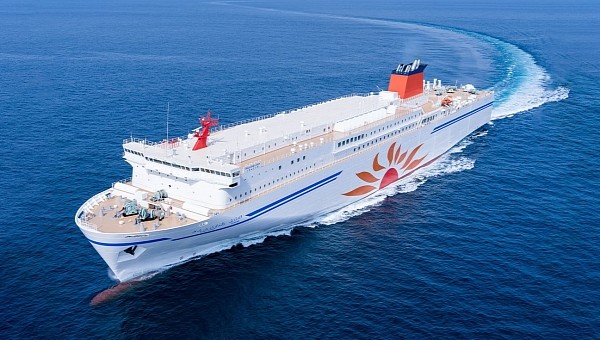Cruise ships and passenger ferries are some of the maritime means of transportation that have made serious steps in reducing harmful emissions. Some switched to hybrid-electric propulsions, others are betting on alternative fuels, such as LNG (Liquefied Natural Gas). The LNG-powered Sunflower Kurenai is becoming a pioneer for green maritime transportation in Japan.
As one of the shipping heavy-hitters not just in Japan, but worldwide, MOL Group (Mitsui O.S.K. Lines) is also at the forefront of the transition towards net-zero operations at sea. It was one of the first companies in this industry, a couple of years ago, to get its future LNG-fueled vessels awarded a top five-star rating by the Ministry of Land, Infrastructure, Transport and Tourism in Japan.
Its vision for the future sounds difficult to implement, but doesn’t beat around the bush: no less than 90 vessels running on alternative fuels, in operation by the end of this decade. Instead of relying on brand-new propulsion systems and ship design, the Japanese group is betting only on LNG, which it considers “the most effective low-emission ship fuel at this time.”
At the beginning of this year, a naming and launching ceremony held at the Mitsubishi Heavy Industries’ facility in the Yamaguchi Prefecture, officially welcomed MOL’s first LNG ferry. As the year is now coming to an end, the pioneering Sunflower Kurenai marked another milestone. It got its first LNG refueling, through a process that is innovative for Japanese shipping.
Usually, a single tank truck is connected directly to the vessel, for the LNG fuel supply. In this case, a skid loading-and-unloading system was used to indirectly connect not just one, but four tank trucks to the Sunflower Kurenai. Boasting 652 feet (199 meters) and a 17,300-ton GT, you can imagine that his mammoth ferry expects a large “meal” each time it’s refueled. That is why MOL came up with this method that helps supply the large quantity of LNG much faster.
This truck-to-ship LNG refueling was a first for Japan, MOL claims, and the Sunflower Kurenai itself is the first ferry of its kind in the country. It will officially kick off commercial operations on January 13, 2023, providing greener trips from Osaka to Beppu. Operated by Sunflower Ferry, a MOL company, it will replace the current, conventional vessel operating on this route.
Not just eco-friendly but also more comfortable for future passengers, the Sunflower Kurenai features an extended pilot’s room, a new three-layer atrium, and more seats available in the restaurant onboard.
Although a pioneer in Japan, Sunflower Kurenai won’t be alone. Its sister LNG-fueled ferry, Sunflower Murasaki, is expected to be delivered next year.
In addition to these ferries, MOL Group also launched an LNG-fueled tugboat, and the world’s largest MOSS-type carrier running on this alternative fuel.
Its vision for the future sounds difficult to implement, but doesn’t beat around the bush: no less than 90 vessels running on alternative fuels, in operation by the end of this decade. Instead of relying on brand-new propulsion systems and ship design, the Japanese group is betting only on LNG, which it considers “the most effective low-emission ship fuel at this time.”
At the beginning of this year, a naming and launching ceremony held at the Mitsubishi Heavy Industries’ facility in the Yamaguchi Prefecture, officially welcomed MOL’s first LNG ferry. As the year is now coming to an end, the pioneering Sunflower Kurenai marked another milestone. It got its first LNG refueling, through a process that is innovative for Japanese shipping.
Usually, a single tank truck is connected directly to the vessel, for the LNG fuel supply. In this case, a skid loading-and-unloading system was used to indirectly connect not just one, but four tank trucks to the Sunflower Kurenai. Boasting 652 feet (199 meters) and a 17,300-ton GT, you can imagine that his mammoth ferry expects a large “meal” each time it’s refueled. That is why MOL came up with this method that helps supply the large quantity of LNG much faster.
This truck-to-ship LNG refueling was a first for Japan, MOL claims, and the Sunflower Kurenai itself is the first ferry of its kind in the country. It will officially kick off commercial operations on January 13, 2023, providing greener trips from Osaka to Beppu. Operated by Sunflower Ferry, a MOL company, it will replace the current, conventional vessel operating on this route.
Not just eco-friendly but also more comfortable for future passengers, the Sunflower Kurenai features an extended pilot’s room, a new three-layer atrium, and more seats available in the restaurant onboard.
Although a pioneer in Japan, Sunflower Kurenai won’t be alone. Its sister LNG-fueled ferry, Sunflower Murasaki, is expected to be delivered next year.
In addition to these ferries, MOL Group also launched an LNG-fueled tugboat, and the world’s largest MOSS-type carrier running on this alternative fuel.






